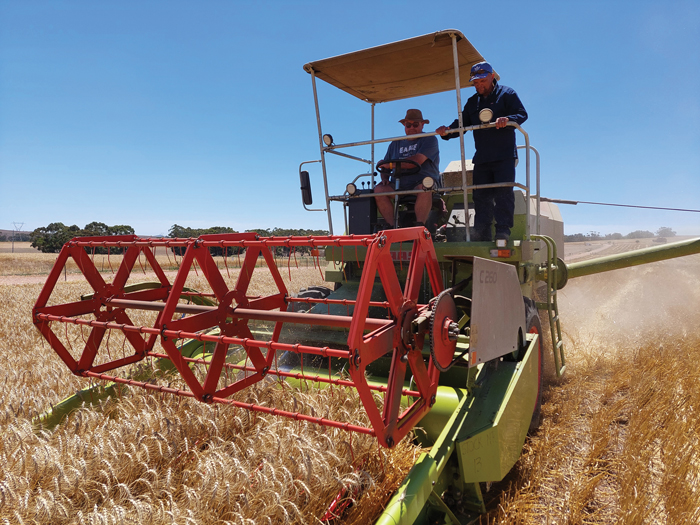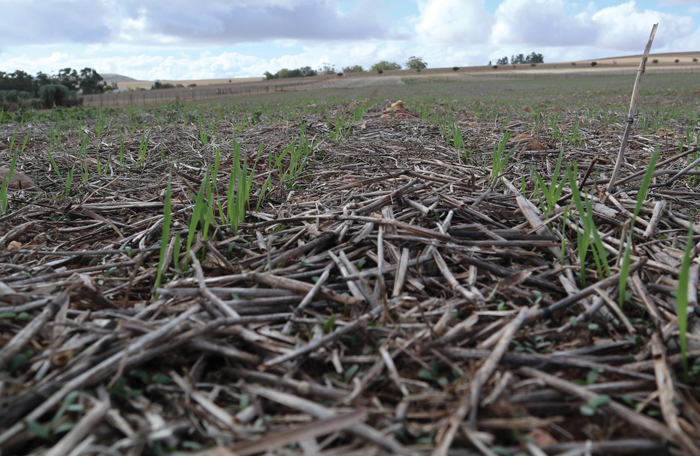
 Dr Johann Strauss, Research and Technology Development Services, Western Cape Depart-ment of Agriculture
Dr Johann Strauss, Research and Technology Development Services, Western Cape Depart-ment of AgricultureThe conservation agriculture and crop rotation trial which has been running for 26 years on Langgewens research farm, can shed some light on the effect of crop rotation and how it influences wheat quality.
Crop rotation systems can increase the quality and quantity of wheat production while chemical inputs are reduced. It must, however, also be said that the use of artificial inputs can lessen the negative effect of an unsuitable crop rotation system.
This statement is explained using the example of a four-year crop rotation system with three years of wheat and one year of canola. This system has low diversity and contains no legumes with 75% wheat. Initially this system will yield a high return on investment. However, it is not sustainable – especially with the current prices of fertilisers and agro-chemicals. In the long term the 75% wheat in the system will lead to an increase in diseases and insects targeting wheat and grass weeds. The only way to fight these problems is with increasing amounts of synthetic inputs. This will lead to increased input costs and pressure on the profitability of the system. In the long run, despite the cost of all these inputs, resistance will build up and weeds will no longer be controlled with herbicides. In order to rectify this, the system will have to be changed or the cycle will just repeat itself.

What is possible with low inputs?
On a more positive note: In 2021 a 6,2 t/ha wheat yield was achieved with a B2 quality (just missing out on a B1 grading) on a grand total of 26 kg/ha applied nitrogen (N). This wheat was planted at 65 kg/ha with 5 kg/ha of N using a Piket double disc planter.
This was the ideal result after a good season where the system with the lowest inputs outperformed all other systems. The argument could be made that if more N was applied in this system, the protein content could have increased and improved the grading to B1. However, the fact that only 10 mm of rain was received in September 2021 – the period when seed fill takes place – complicates this argument. If more N had been applied, it could have decreased the yield due to the dry September. Systems where 87 kg/ha N were applied, had much lower yields and protein content with a grade other grading.
The determining factor which led to the wheat with 26 kg/ha applied N outperforming the wheat with 87 kg/ha N, was the addition of effective legumes to the system. When legumes are effectively included into the system, nitrogen-binding rhizobia on the roots will take N out of the air, fix it in the nodules and eventually release it into the soil. It is crucial to create favourable conditions for rhizobia if one wants them to fix N in the system rather than buying the N, especially at current prices.
The 6,2 t/ha wheat yield was obtained on a wheat and medics (legume) system. Although this system only contains 50% wheat, it was more profitable than all other systems, including wheat monoculture and three years of wheat and one year of canola. This is true for the average of the 26-year lifespan of the trial. The medics are grazed by sheep, but grazing is managed in order to have sufficient root growth on the medics. Rhizobium is dependent on the roots in order to bind N. Thus, if medics are overgrazed, root mass decreases and less N will be fixed. The benefit of managing legume pastures is not just limited to fixation of N in the soil, but also because legumes use this N to produce protein. In short, if legume pastures are correctly managed the production of livestock and wheat are improved with reduced input costs.
Although there is a strong focus on medics, other legumes including lupines and mainly legume cover crops had similar effects and have led to an increase in quality and production. This highlights two points:
- N fixed by plants is more effective compared to N applied from a bag.
- Depending on the annual climatic conditions, applied chemical N does not guarantee ideal wheat protein.
The necessity of legumes
The advantage of legume pastures in a cropping system, is the benefit of animals as a non-chemical weed control agent, reducing the risk of herbicide-resistant weeds. It has to be taken into account that legumes are climate- and soil pH-specific, thus the correct choice of legume should be made for a specific area and it should also be properly inoculated with the correct rhizobium.
On the other hand, there is a big difference between selecting the ideal crop rotation system in order to improve production and minimise inputs compared to managing the system correctly. For example, when a legume is in a crop rotation system and N fertiliser is applied as usual, it creates two flaws in the system. Firstly, wheat following legumes should receive less N in order to utilise all the fixed N and reduce input costs. Secondly, high concentrations of applied N can kill or cause a lower fixing rate by the rhizobium. This means that if one has legumes following wheat which received a lot of N fertiliser and there is residual N in the soil from the previous year, the rhizobium will fix less N. Thus in short, a system must be structured in such a way that the full potential of the system is unlocked.
There is no perfect crop rotation system and it should be flexible in order to address limitations and specific constraints. The addition of legumes in crop rotation systems can reduce inputs while increasing production if rhizobium is taken care of.

Conclusion
Producers should limit artificial inputs and only apply something if they are certain it will lead to an increase in profits in the long term. This means everything has to be based on site-specific data (soil samples) and in-field observations. Do not use a fixed recipe that does not take variation into account and is normally designed for production and not necessarily profitability. This is especially true in conservation agriculture where one wants to utilise natural processes in the soil as far as possible. With the current steep upward trend of input costs, it is essential to utilise all other natural resources optimally in order to stay profitable.





























